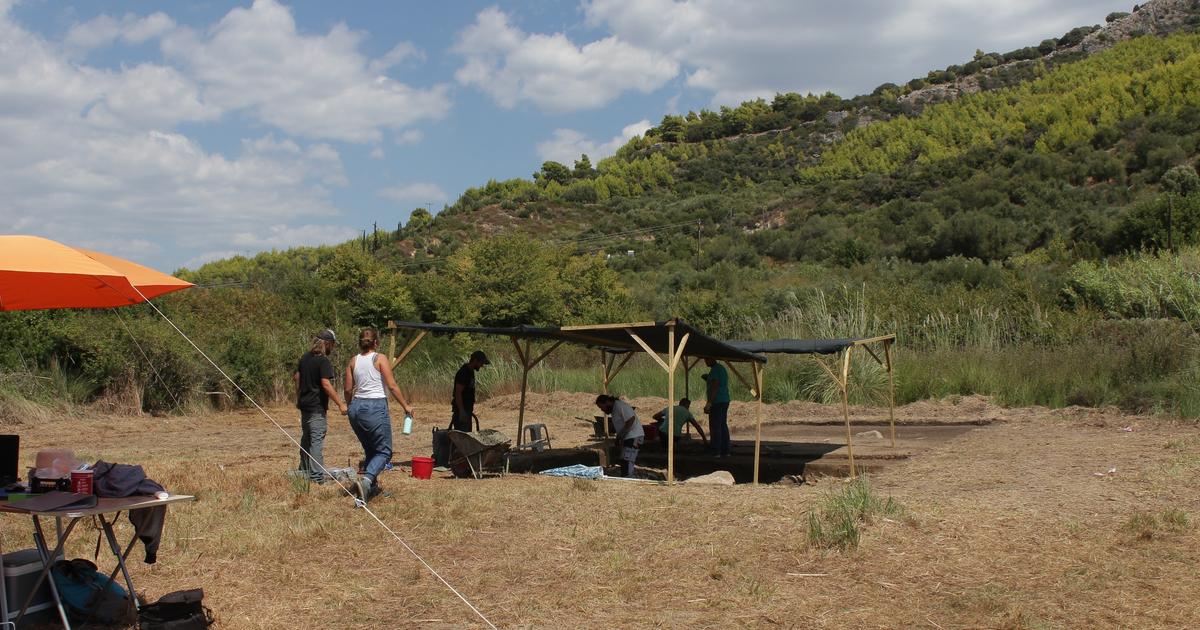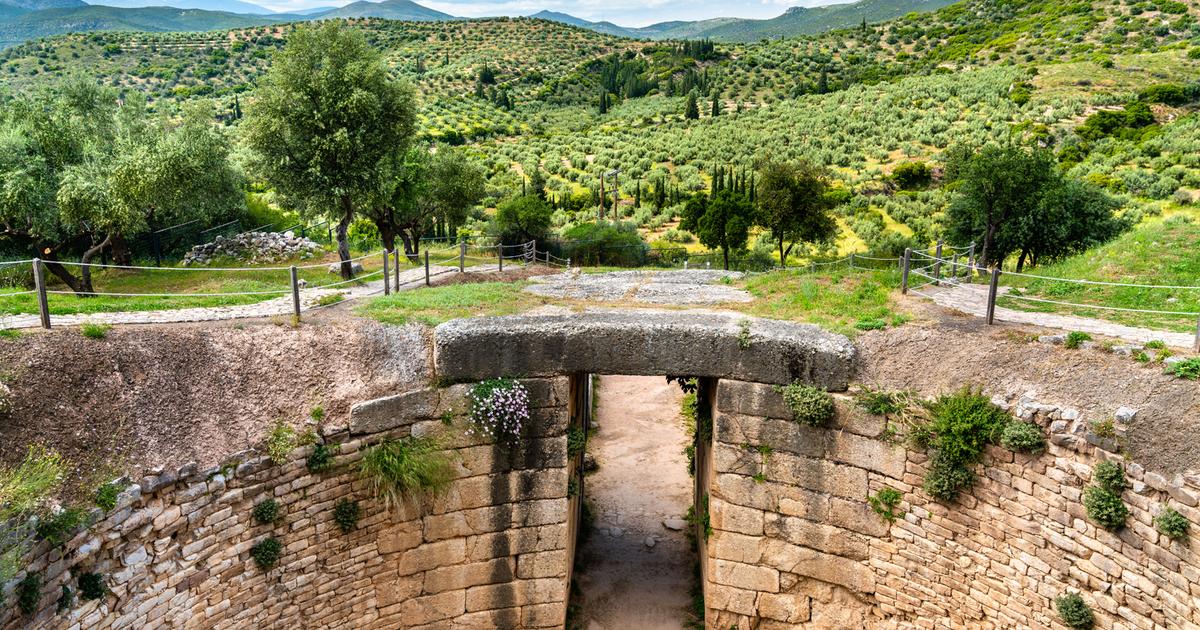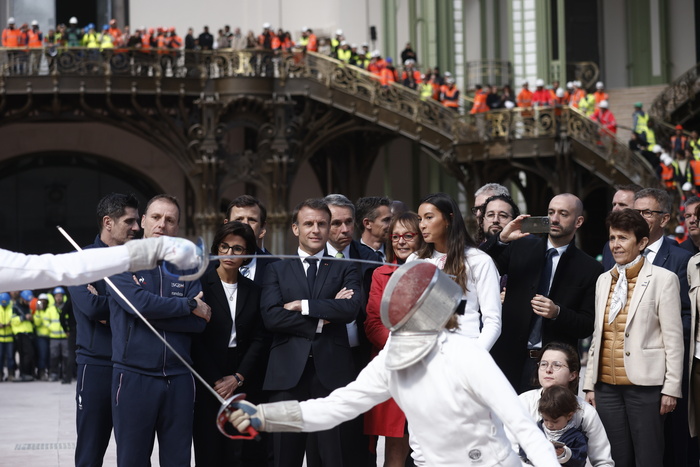The archaeologist did not expect to hear the long-awaited news in such a cavalier tone.
In October 2021, the Austrian researcher Birgitta Eder led with her Greek colleague Erofili-Iris Kolia a survey campaign carried out on the Kleidi-Samikon site.
Located about 10 kilometers south of Olympia, in the center of the eastern coast of the Peloponnese, the site is punctuated for several days by slow geophysical surveys and some laborious drilling carried out in the middle of fields of reeds and orchards that dot the western slope. of Mount Lapithas.
The archaeologists are struggling to find the ancient sanctuary they are chasing, until the day when a colleague finally comes to the Austrian researcher:
"You have ordered a temple!"
, he exclaims, triumphant.
Two millennia after its abandonment, the sanctuary of the Poseidon of Samikon had just been found.
“I was stunned to say the least, but on the magnetometer screen you could clearly see the plan of a building whose structure evoked that of a temple”
, said Birgitta Eder, on October 31, during a presentation at the Austrian Archaeological Institute in Athens - an institution dependent on the Austrian Academy of Sciences - of which she is the director.
Read also Parthenon friezes: the debate on their return to Greece “is not closed”, assures Athens
“The identification of the remains discovered with this historic site is supported by the ancient sources which locate the sanctuary of Poseidon just below the ancient fortress of Samikon”,
specified Birgitta Eder for
Le Figaro
.
Familiarity with the waves and the rock
An important center of worship in the region, the sanctuary of Samikon is indeed mentioned by the Greek geographer and historian Strabo at the end of the 1st century BC.
AD. Two millennia later, the prose of the ancient scholar was not enough.
The Elidian residence of the Greek god of the sea has stubbornly escaped the tools of archaeologists, despite several excavations carried out on the sea side of Lapithas since the beginning of the 20th century.
Until recently, at least.
Read alsoNotre-Dame de Paris: Emmanuel Macron confirms a reopening in 2024
The place of worship spotted during the successful prospection of 2021 was the subject of a formal excavation the following year, between August and September 2022. The operation was carried out under the direction of the Austrian Archaeological Institute and the Ephoria of Elis, under the responsibility of Erofili-Iris Kolia.
More specialized teams from the universities of Mainz and Kiel also took part in this first excavation campaign of the sanctuary.
Researchers probe the depths of the Kleidi-Samikon site in September 2021, during a geo-archaeological prospecting campaign on the slopes of Mount Lapithas.
Austrian Archaeological Institute Athens
Perched on the side of the mountain, the Poseidonian site familiarized with both the waves and the rock.
This was no coincidence, according to the German researchers on the team.
“It is possible that this location was explicitly chosen because of the extreme phenomena that were sweeping the region
,” said a statement from the University of Mainz published on Wednesday, after highlighting the recurrence of tsunamis in this part of the Ionian Sea and the security offered by the heights of the mountain sides.
Homer himself decked out the god of the sea with the a priori paradoxical epithets "Shaker of the ground" and "Master of the earth".
Read also“It’s a historic moment”: in Strasbourg, the return of the missing parchment
Finally remained the possibility that it was another temple of the sanctuary of Poseidon, a place of worship of Heracles for example.
In order to verify the geophysical readings, the researchers thus chose to focus on a first restricted but strategic perimeter, i.e. the transition space between the
pronaos
- the vestibule of the temple, open to the outside - and the
cella
- the enclosed sacred area where the cult statue stood.
A wise choice: the excavation of this area, the backbone of the complex, has enabled archaeologists to adjust their estimates vis-à-vis the sanctuary.
And, above all, to revise them upwards.
Greek temple and god of the sea
“The excavation campaign revealed that what we had taken for a
pronaos
actually corresponded to a new room, which means that the dimensions of the building are actually larger,”
explained Birgitta Eder.
The temple would thus be at least 28 meters long, with a thickness of about 9.40 meters at the foundations.
Not enough to steal the show from the Parthenon, in Athens, of course, but beautiful dimensions despite everything.
Several clues to the unearthed remains, such as a marble basin, as well as the Laconian style of the quantities of piled up tiles, would date this set from the Archaic period, around the 6th century BC.
View of the first stripped portion of the Temple of Poseidon, with part of the
cella
and a second room of the building, in September 2022. Greece Culture Ministry
Archaeologists thus think they have found the trace not of an annex structure, but indeed of the main temple of the sanctuary of Poseidon.
The monument, visible from the coast, was located between the fortress of Samikon, built later, in the 4th century BC.
AD, and the port of Kleidi.
The whole formed an important agglomeration of the ancient region of Triphylia, which reached its peak at the beginning of the Hellenistic period, in the 3rd century BC.
Read alsoThe remains of a Roman mausoleum decorated with a monstrous triton discovered in Auvergne
For Birgitta Eder, the discovery of the sanctuary thus makes it possible to complete knowledge of the ancient topography of the site, since the fortress, which overlooked the city and the port of Kleidi, was already studied about fifteen years ago.
Added to this is also the ancient excavation of Mycenaean remains in the city.
These traces dated to the second millennium BC.
J.-C. had however not put the archaeologists of formerly on the trace of the Greek part of the agglomeration.
"The discovery of the temple nevertheless opens up new perspectives on the political and economic importance of the amphictyonia
(federation, Ed.)
of the cities of Triphylia in the 6th century BC, including the sanctuary of Poseidon at Samikon was the center of their religious and ethnic identity,”
summarizes Birgitta Eder.
While waiting to find the Greek port of Kleidi-Samikon one day, archaeologists still have four excavation campaigns ahead of them to complete the exhumation of the temple of Poseidon.









